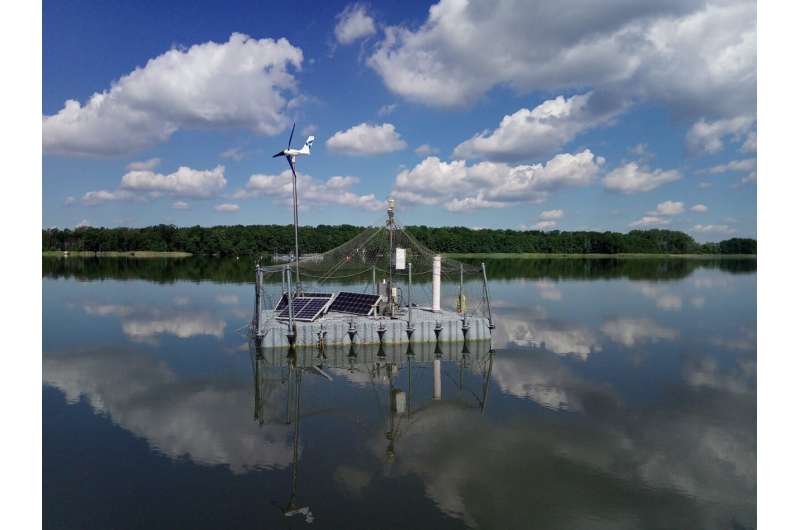This article has been reviewed according to Science X's editorial process and policies. Editors have highlighted the following attributes while ensuring the content's credibility:
fact-checked
peer-reviewed publication
proofread
Modeling study reveals German lake conditions under climate change

Using long-term monitoring data from 46 German lakes, researchers from the Leibniz Institute of Freshwater Ecology and Inland Fisheries (IGB) in cooperation with the Helmholtz Center for Environmental Research in Magdeburg have shown that surface temperatures of lakes have risen faster than air temperatures over the last 30 years.
Oxygen concentrations in the deep water have decreased. Modeling suggests that this trend will continue. The good news is that the lack of oxygen in the hypolimnion would be alleviated if the nutrient loads from urban and agricultural discharges could be reduced. The study is published in the journal Ambio.
As lakes warm, their oxygen content decreases. This is partly due to the oxygen solubility in water, which is lower at higher temperatures. In addition, warmer temperatures cause thermal stratification with a warmer surface layer on top of colder water.
If this stratification persists for a long time in summer, oxygen can be depleted by organisms in the deep zone, but can not be replenished due to a lack of mixing. The resulting low oxygen concentrations can be problematic for all forms of higher life.
The research team used long-term data spanning over at least 30 years and hydrodynamic models to investigate how water temperature, lake stratification and oxygen concentrations in the deep layer of 46 German lakes change in response to climate warming.
Analysis of long-term data shows that the average annual surface temperature of all lakes has risen by 0.5 degrees Celsius per decade (°C/decade) between 1990 and 2020. This means that German lakes have warmed more strongly than the air over the same period, with an increase of 0.43 °C/decade. Water temperature in the deep water has remained almost constant.
Between 1990 and 2020, oxygen concentrations were below 2 milligrams per liter (mg/L) in 51% of summer measurements and 62% of autumn measurements. This concentration is considered to be a critical threshold for the survival of many freshwater organisms.
"The occurrence of low-oxygen conditions has increased in parallel with warmer temperatures, especially in autumn. This is due to the more stable thermal stratification," explained IGB researcher Robert Schwefel, lead author of the study.
Climate change: Longer thermal stratification, not increasing temperatures, is the main driver of deoxygenation
The researchers used hydrodynamic lake models to simulate future temperature and oxygen trends up to the year 2099 based on different emission scenarios of the Intergovernmental Panel on Climate Change (IPCC). Simulations were performed on 12 lakes for which high-resolution measurement data was available for model calibration.
Under the pessimistic emissions scenario RCP 8.5, which assumes a continuous increase in greenhouse gases until the end of the century, the surface temperature of the lakes would continue to rise by 0.3°C/decade until 2099.
In the intermediate scenario, RCP 4.5, the increase is only 0.18°C/decade. For the optimistic RCP 2.6 scenario, in which the increase in air temperature is limited to about 2°C above pre-industrial levels, only a minimal increase of 0.04°C/decade is predicted. Consistent with observations over the last thirty years, the temperature at depth would rise much less.
"The increasing temperature difference between the surface and the deep layer increases the temperature stratification," explained IGB researcher Michael Hupfer, who led the project.
The model calculations show that under the pessimistic emissions scenario, summer stratification would be extended by up to 38 days by the end of the century compared to the period from 2006 to 2016 (by 22 days for RCP 4.5 and 13 days for RCP 2.6).
The increasing stratification increases the risk of oxygen depletion in the deep layer: Using a simplified oxygen model, the team showed that oxygen concentrations in the deep layer would decrease by 0.7 to 1.9 mg/L in response to the extended stratification period (RCP 4.5 by 0.6 mg/L, or RCP 2.6 by 0.2 mg/L).
"This means that larger areas of the hypolimnion would remain hypoxic or even anoxic, especially in autumn. This would heavily impact fish habitats and the chemical conditions in the lake sediments," said IGB researcher Robert Schwefel.
Reduced nutrient loads could mitigate negative effects
To mitigate the effects of climate change, other stressors can be reduced, such as nutrient loads like nitrates and phosphates from urban and agricultural discharges. These act as fertilizers in water bodies and stimulate biological processes such as algae growth. In turn, oxygen consumption in the deep waters increases as more oxygen is depleted during subsequent decomposition processes.
In their study, the team also modeled the combined effect of climate change and reduced nutrient inputs on the oxygen balance. The good news: Even in the most pessimistic emissions scenario, a reduction in nutrients by one trophic state level would lead to increased oxygen concentrations, which would mitigate the effects of warming.
In the most pessimistic climate scenario, RCP 8.5, oxygen concentrations in the deep water increased when oxygen consumption in the deep water was assumed to be typical for conditions with reduced nutrient inputs.
"Our results indicate that the negative effects of climate change on the oxygen balance of lakes can be effectively mitigated by increased efforts to limit nutrient inputs," said Hupfer.
More information: Robert Schwefel et al, Temperatures and hypolimnetic oxygen in German lakes: Observations, future trends and adaptation potential, Ambio (2024). DOI: 10.1007/s13280-024-02046-z
Journal information: AMBIO
Provided by Leibniz-Institut für Gewässerökologie und Binnenfischerei (IGB)





















